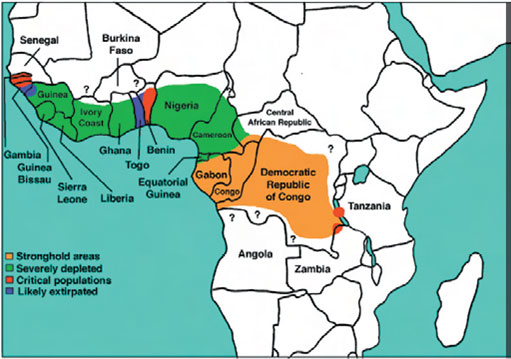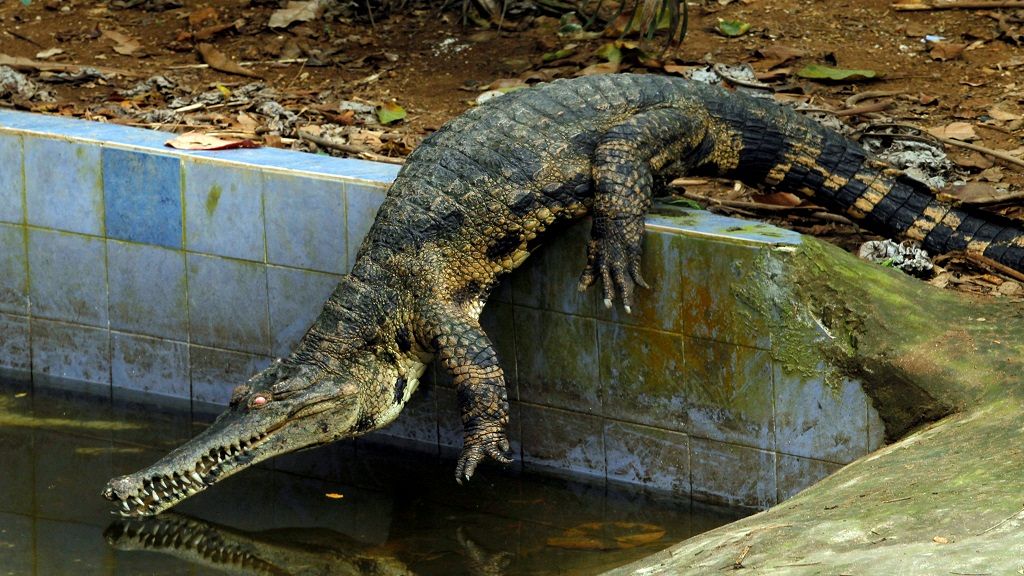Post by Ceratodromeus on Jan 29, 2016 10:45:03 GMT 5

Scientific classification
Kingdom: Animalia
Phylum: Chordata
Subphylum: Vertebrata
Class: Reptilia
Order: Crocodylia
Family: Crocodylidae
Subfamily: Crocodylinae
Genus: Mecistops
Species: M. cataphractus
Description
This is a mid sized species of crocodile, with adult animals measuring around the 3m(9.8ft)mark. The largest recorded animal measured approximately 4m(13ft){1} in total length. They resemble the false gharial(Tomistoma) in body coloration and morphology, possessing a mottled dark brown and tan coloration. Distinctive dark colored barring can be found on the lower jaw. The elongated snout which gives the species its common name is an adaptation commonly seen in the Crocodylidae family. This helps reduce drag while the animal is hunting fish or other aquatic animals. Studies in the early 2000's have established that this species is distinct from the Crocodylus genus, based on mitochondrial and nuclear DNA analysis{2}.

Habitat & Geographic distribution
This species is never found to be far from the water, preferring rivers and tributaries with overhanging foliage which provide cover sun exposure. Their numbers have been depleted over the years due to over hunting, but they can be found from Guinea, to the Democratic Republic of Congo. There is a range overlap with the African dwarf crocodile, but avoid excessive competition via dissimilar ecological niches & different habitat preferences{1}.
 .
.Dietary habits
The vast majority of this species' diet consists of fish, such as claroteid catfish(Chrysicthys spp.), Distichodus notospilus, Characidiform fishes(nanopetersius spp.), and Cichlids(Tilapia spp.){3}. However, they are known to prey on an array of mammals and birds. Known prey animals include small rodents (Rodentia), Duikers(Cephalophinae), gennets(Viverrinae), and primates(Cercopithecus sp.). Observations on this species indicate the slender snouted crocodile feeds on annelids, amphibians, and small reptiles{1}.
Reproduction
Mating occurs in the rainy season of this species' distribution, around April. Not much is known on the reproduction(or much of the species natural history) of the slender snouted crocodile. However, observations of the species indicate that it constructs nest mounds out of vegetation it finds close to the waters' edge. In fact, not even the mounds are constructed far(approximately 3m) from the water. The mounds measure roughly 58cm(22.8in) in height, 134cm(52in) long, and 152cm(59in) in width. A typical clutch size numbers 16(+/-7); the individual eggs measure around 85.5mm(3.3in) in length, and are 52mm(2in) in diameter. The eggs hatch in July, around 130 days after being laid. Like all other crocodilians, the maternal animal will often guard the clutch until the eggs hatch. Upon hatching, the young measure 315mm(12.4in) in total length. The maternal animal will free the young once she hears the young vocalizing -- a trademark behavior of the Crocodylidae{1}.
References
{1} Waitkuwait, W. E. "Present knowledge on the West African slender-snouted crocodile, Crocodylus cataphractus Cuvier 1824 and the West African dwarf crocodile Osteolaemus tetraspis, Cope 1861." Crocodiles. Their Ecology, Management, and Conservation (1986): 260-275.
{2}McAliley, L. Rex, et al. "Are crocodiles really monophyletic?—evidence for subdivisions from sequence and morphological data." Molecular phylogenetics and evolution 39.1 (2006): 16-32.
{3}Pauwels, Olivier SG, et al. "Diet records for Crocodylus cataphractus (Reptilia: Crocodylidae) at Lake Divangui, Ogooué-Maritime Province, south-western Gabon." HAMADRYAD-MADRAS- 27 (2003): 200-204.




